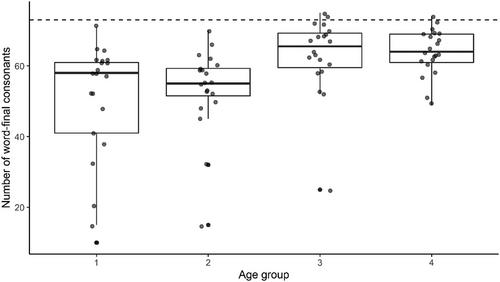Approximately 50% of all young children with a developmental language disorder (DLD) also have problems with speech production. Research on speech sound development and clinical diagnostics of speech production difficulties focuses mostly on accuracy; it relates children's phonological realizations to adult models. Contrarily to these relational analyses, independent analyses indicate the sounds and structures children produce irrespective of accuracy. Such analyses are likely to provide more insight into a child's phonological strengths and limitations, and may thus provide better leads for treatment.
Ram (1) To contribute to a more comprehensive overview of the speech sound development of young Dutch children with DLD by including independent and relational analyses, (2) to develop an independent measure to assess these children's speech production capacities; and (3) to examine the relation between independent and relational speech production measures for children with DLD.
We describe the syllable structures and sounds of words elicited in two picture-naming tasks of 82 children with DLD and speech production difficulties between ages 2;7 and 6;8. The children were divided into four age groups to examine developmental patterns in a cross-sectional manner. Overviews of the children's productions on both independent and relational measures are provided. We conducted a Spearman correlation analysis to examine the relation between accuracy and independent measures.
The overviews show these children are able to produce a greater variety of syllable structures and consonants irrespective of target positions than they can produce correctly in targets. This is especially true for children below the age of 4;5. The data indicate that children with DLD have difficulty with the production of clusters, fricatives, liquids and the velar nasal (/ŋ/). Based on existing literature and our results, we designed a Dutch version of an independent measure of word complexity, originally designed for English (word complexity measure—WCM) in which word productions receive points for specific word, syllable and sound characteristics, irrespective of accuracy. We found a strong positive correlation between accuracy scores and scores on this independent measure.
The results indicate that the use of independent measures, including the proposed WCM, complement traditional relational measures by indicating which sounds and syllable structures a child can produce (irrespective of correctness). Therefore, the proposed measure can be used to monitor the speech sound development of children with DLD and to better identify treatment goals, in combination with existing relational measures.
Speech production skills can be assessed in different ways: (1) using analyses indicating the structures and sounds a child produces irrespective of accuracy, that is, performance analyses; and (2) using analyses indicating how the productions of a child relate to the adult targets, that is, accuracy analyses. In scientific research as well as in clinical practice the focus is most often on accuracy analyses. As a consequence, we do not know if children who do not improve in accuracy scores, improve in other phonological aspects that are not captured in these analyses, but can be captured by performance analyses.
The overviews show these children are able to produce a greater variety of syllable structures and consonants irrespective of target positions than they can produce correctly in targets. Consequently, adding performance analyses to existing accuracy analyses provides a more complete picture of a child's speech sound development.
We propose a Dutch version of a WCM, originally designed for English, in which word productions receive points for word structures, syllable structures and sounds, irrespective of accuracy. This measure may be used by Dutch clinicians to monitor the speech sound development of children with DLD and to formulate better treatment goals, in addition to accuracy measures that are already used.



